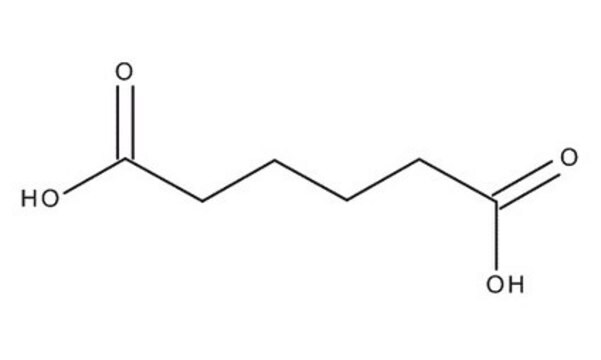P45001
Pimelic acid
98%
Sinonimo/i:
Heptanedioic acid
Autenticatiper visualizzare i prezzi riservati alla tua organizzazione & contrattuali
About This Item
Formula condensata:
HO2C(CH2)5CO2H
Numero CAS:
Peso molecolare:
160.17
Beilstein:
1210024
Numero CE:
Numero MDL:
Codice UNSPSC:
12352100
ID PubChem:
NACRES:
NA.22
Prodotti consigliati
Livello qualitativo
Saggio
98%
Forma fisica
crystals
P. eboll.
212 °C/10 mmHg (lit.)
Punto di fusione
103-105 °C (lit.)
Stringa SMILE
OC(=O)CCCCCC(O)=O
InChI
1S/C7H12O4/c8-6(9)4-2-1-3-5-7(10)11/h1-5H2,(H,8,9)(H,10,11)
WLJVNTCWHIRURA-UHFFFAOYSA-N
Cerchi prodotti simili? Visita Guida al confronto tra prodotti
Descrizione generale
Pimelic acid, also known as heptanedioic acid, is a dicarboxylic acid commonly used as a precursor in the biosynthesis of biotin. It serves as a building block in the synthesis of various compounds , and it is used as a key precursor in the production of polyamides, polyesters, and other polymers.
Applicazioni
- Pimelic acid in microbial soil treatments: A 2023 study examined the use of pimelic acid in soil treatment, observing its impact on the microbial community structure and metabolites in bayberry plantations. This application illustrates its potential in agricultural biotechnology and soil remediation (Ren et al., 2023).
- Pharmaceutical applications of pimelic acid: A 2023 study involved pimelic acid in the preparation and physiochemical analysis of novel ciprofloxacin/dicarboxylic acid salts, showcasing its utility as a pharmaceutical intermediate (Hibbard et al., 2023).
Avvertenze
Warning
Indicazioni di pericolo
Consigli di prudenza
Classi di pericolo
Eye Irrit. 2 - STOT SE 3
Organi bersaglio
Respiratory system
Codice della classe di stoccaggio
11 - Combustible Solids
Classe di pericolosità dell'acqua (WGK)
WGK 2
Punto d’infiammabilità (°F)
Not applicable
Punto d’infiammabilità (°C)
Not applicable
Dispositivi di protezione individuale
dust mask type N95 (US), Eyeshields, Gloves
Scegli una delle versioni più recenti:
Possiedi già questo prodotto?
I documenti relativi ai prodotti acquistati recentemente sono disponibili nell’Archivio dei documenti.
I clienti hanno visto anche
B R Pettit
Clinica chimica acta; international journal of clinical chemistry, 156(1), 85-90 (1986-04-15)
A selected ion monitoring assay for thiodiglycollic acid in urine is described. Urine samples are analysed by combined gas chromatography-mass spectrometry as their dibutyl esters using pimelic acid as an internal standard. Rapid analysis was achieved by the simplification of
V G Mahadevappa et al.
Biochimica et biophysica acta, 713(1), 73-79 (1982-10-14)
The molecular species composition of the individual diacyl phospholipids was determined in human platelets. The 1-acyl (16:0, 18:0, etc.) homologues of the various 2-acyl (16:0, 18:1, 18:2, 20:4, etc) species of the phosphatidylcholine, phosphatidylethanolamine, phosphatidylserine and phosphatidylinositol were assessed by
S Passi et al.
Acta dermato-venereologica. Supplementum, 143, 8-13 (1989-01-01)
Medium chain length dicarboxylic acids (DA) from C8 to C13 are competitive inhibitors of tyrosinase in vitro. The introduction of electron acceptor groups or electron donor groups into the 2 and/or the 8 position of the molecule enhances or reduces
T Niwa et al.
Clinica chimica acta; international journal of clinical chemistry, 99(1), 71-83 (1979-11-15)
(1) 2,4-Dimethyladipic acid was first identified in normal human urine using gas chromatography-mass spectrometry. Urinary excretion of 2,4-dimethyladipic acid in 7 healthy adults ranged from 4.9 mumol to 14 mumol per 24 h. (2) Succinic acid, adipic acid, 3-methyladipic acid
Concentrations of riboflavin and related organic acids in children with protein-energy malnutrition.
C D Capo-Chichi et al.
The American journal of clinical nutrition, 71(4), 978-986 (2000-03-25)
Riboflavin, flavin mononucleotide (FMN), and flavin adenine dinucleotide (FAD) concentrations have been little studied in cases of malnutrition. Our objective was to investigate the effects of malnutrition on riboflavin status and riboflavin's relation with thyroid hormones and concentrations of urinary
Il team dei nostri ricercatori vanta grande esperienza in tutte le aree della ricerca quali Life Science, scienza dei materiali, sintesi chimica, cromatografia, discipline analitiche, ecc..
Contatta l'Assistenza Tecnica.











